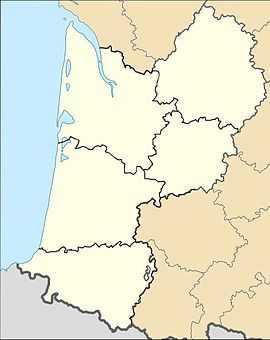Agonac
| Agonac | |
|---|---|
|
| |
 Agonac | |
|
Location within Aquitaine region  Agonac | |
| Coordinates: 45°17′36″N 0°45′03″E / 45.2933°N 0.7508°ECoordinates: 45°17′36″N 0°45′03″E / 45.2933°N 0.7508°E | |
| Country | France |
| Region | Aquitaine |
| Department | Dordogne |
| Arrondissement | Périgueux |
| Canton | Brantôme |
| Government | |
| • Mayor (2008–2014) | Jean-Claude Brouillaud |
| Area1 | 37.22 km2 (14.37 sq mi) |
| Population (2008)2 | 1,625 |
| • Density | 44/km2 (110/sq mi) |
| INSEE/Postal code | 24002 / 24460 |
| Elevation | 110–224 m (361–735 ft) |
|
1 French Land Register data, which excludes lakes, ponds, glaciers > 1 km² (0.386 sq mi or 247 acres) and river estuaries. 2 Population without double counting: residents of multiple communes (e.g., students and military personnel) only counted once. | |
Agonac is a commune in the Dordogne department in Aquitaine in southwestern France. It is situated on the small river Beauronne, 12 km (7.5 mi) north of Périgueux.
Population
| Historical population | ||
|---|---|---|
| Year | Pop. | ±% |
| 1962 | 1,113 | — |
| 1968 | 1,162 | +4.4% |
| 1975 | 1,027 | −11.6% |
| 1982 | 1,059 | +3.1% |
| 1990 | 1,342 | +26.7% |
| 1999 | 1,451 | +8.1% |
| 2008 | 1,625 | +12.0% |
History
The settlements "Borie-Vieille" and "Les Cadagnes" have yielded prehistoric remains.
In the 11th century, the village was built on a hill controlling valleys with difficult access. Agonac was one of four fourtresses and protected the area from the Norman invasions.
See also
References
External links
| Wikimedia Commons has media related to Agonac. |